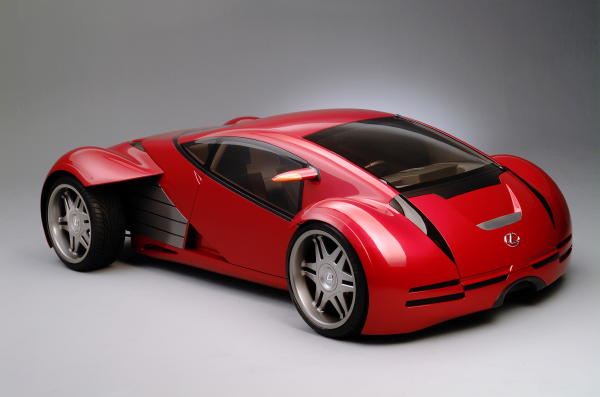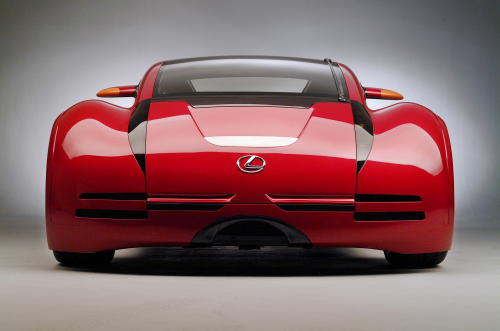


Introduction
I fell in love with this car design while browsing thorugh the Sharper Image store in Stanford Shopping Mall. I bought a model, and the press kit of this car. I also did an extensive research on the car's design, conceptualization, and background. Conveniently, Lexus had compiled a number of press releases on June 18, 2002 for promotion of this car. All informations in regards to this are directly taken from Lexus press releases.
Lexus 2054 Sports Car



Specifications:
In the year 2054, some cars will be self-cleaning, some will drive in an accident free system, and some will change colors on command.
At least that's the vision of the future in Steven Spielberg's upcoming film "Minority Report," starring Tom Cruise. The film, based on a short story by science fiction writer Philip K. Dick, is an action-detective thriller set in Washington, D.C. in 2054, where police utilize a psychic technology to arrest and convict murderers before they commit their crime. Tom Cruise plays the head of this precrime unit and is himself accused of the future murder of a man he hasn't even met.
When it came time to conceptualize automotive transportation for the futuristic setting, Spielberg turned to Lexus as a potential partner. "I've been driving a Lexus SUV," Spielberg said. "And I thought Lexus might be interested in going into a speculative future to see what the transportation systems and cars would look like on our highways in 50 years. The result of that exploration is something that elevates and transforms driving into an environmental experience."
Imagining the Future
Conceptualizing and creating the film's 2054 setting - including its transportation systems - began nearly three years ago. From the outset, Spielberg wasn't interested in creating a fantastical science fiction film but, rather, a future reality film. The first step was to call together a diverse team of designers and futurists to speculate on what the year 2054 might actually look like. Among the participants were conceptual artist Harald Belker and representatives from Calty, the Toyota/Lexus design studio in Southern California.
Discussions were wide-ranging and included topics such as the future of medical advancements, social theories, defense issues, advertising, infrastructure, technology, workplace and household appliances, and of course, cars. There was talk of new inventions, including iris colorants, anti-boredom gelcaps, additional alphabet letters, spray meat, and magnetic levitation transportation systems. These early sessions would inform much of the design of the futuristic world of "Minority Report." Belker - whose film credits include "Batman & Robin," "Inspector Gadget" and "Armageddon" was commissioned to design the film's vehicles, including cars for a vast urban magnetic levitation (MAG-LEV) system, as well as an individual off-system car for driving outside the city. Lexus provided design and luxury cues for the cars, and gave Belker the lowdown on advanced interior technology. "That sophisticated, forward thinking for cars is really a hallmark of Lexus," says Belker.
The MAG-LEV System
In the film's design for its Washington, DC setting circa 2054, a mass transportation system uses electrical/magnetic energy - much like that which sends a bullet train speeding along - with horizontal and vertical surfaces covered with "roadways" made of magnetic discs that support and propel various vehicles. In this accident-free, computer-controlled system, vehicles move at speeds of 80 to 100 miles per hour. In the city's transportation layout, private pods, taxis and multi-passenger cars all negotiate the MAG-LEV system. As cars travel, they make seamless transitions between vertical and horizontal surfaces.
"We discussed how a future goal will be individual transportation within a mass transport system," says Belker. "The discussion gravitated from traveling in personal cabins, into the direction of a futuristic car which works on a MAG-LEV system ö something between a capsule and a car."
The result is a car which travels up an apartment building, for example, to "dock" at a person's residence. Once there, a door slides open that doubles as a living room window; at that point, the carâs seats can even provide additional seating in the living room. While parked, the car performs maintenance checks, auto-repairs, recharges and self cleans.
When residents enter their car to depart back onto the system, they are essentially stepping from the living room into another room of the house. In fact, inside the car, the seats and furnishings bear more relation to a room environment than a car. Highly-styled, comfortable seats conform to individual bodies; seating configurations can be changed so passengers can face forward or each other. The entire environment lends itself to a video screen which allows the "driver" to perform a multitude of functions. . .none of which has to do with driving.
The Off-System Sports Car
For scenes calling for Cruise's character to drive outside the city limits, a radical red off-system sports car was designed and tailor-built to fit the star. While this car isn't likely to be on Lexus showroom floors in 2054, the red Lexus sports coupe is more similar to present-day vehicles-featuring the familiar four wheels and designed to be driven on a traditional road system. In designing the sports car, Belker says, "the goal was to create something unlike anything seen before, and really give it the 'WOW!' effect. We set out to have a lot of fun with it for a big bang impact."
In the end, this futuristic Lexus - designed as a high-performance, two-seat personal sports car - flexes a muscular design with the ultimate in cab-forward seating; a low, enclosed wheelbase for sportiness; aggressive lines, and proportions so unexpected that, at first glance, it's not entirely evident which end is the front and which is the rear.
Conceptually, this sports car features an electric engine, heads-up instrumentation with night vision and organic recognition capability, color-selectable body panels (changeable with a simple owner voice command), DNA recognition entry and ignition system, and auto valet - a feature that allows the car to drop the owner off at a desired location, park itself for recharging, and arrive for owner pick-up at the commanded location.
Making the cars. . .from abstract to "action!"
Once the vehicle needs for the film were identified, Belker started sketching, creating fairly tight illustrations which would first be presented to production designer Alex McDowell ("Fight Club," "The Crow") and then, Spielberg. Spielberg would provide his input, make suggestions and modifications, and Belker would incorporate his notes in a fresh design.
From the approved sketches and renderings, Belker and his staff built 3-D models, pacing themselves quickly to meet deadlines. Being handed several sketches of different pieces each morning - such as knobs, seats, wheels, windshields - Belker's designers would model through the afternoon. By the next day they would ship out the model and e-mail the blueprint of another piece to CTEK, the Santa Ana, California-based technology design and development firm chosen to construct the cars.
Of course, Belker says, part of the process was picking out features like fabric and colors. "Since Lexus is all about luxury and comfort, we had to meet those standards as well. . . although sometimes in movie cars, it's more about the look than the actual cushiness."
When the designs got to CTEK, the engineering department would sort out demands for such facets as metal and electrical components. Then, when the 3-D models were turned in, CTEK would build the vehicles to full-size specifications.
Each vehicle had certain requirements. In the case of the red off-system sports car, it had to be fully-electric and maintain 70 miles per hour for stretches of time. Even though, in automotive parlance, that car was deemed a "concept car," it had to be functional: doors had to open, the steering wheel had to tilt, seats had to recline. And of course, to reach top velocity and perform on-screen as well as it does, the coupe - powered by 47 batteries and an all-electric motor - required an intact four speed standard shift with reverse. Post-production computer-generated special effects create the coupe's futuristic instrumentation, including a "heads-up display" (an on-windshield projection providing a clear view of controls and gauges a driver would typically have to look down for).
For the MAG-LEV vehicle, rotating pods substitute for wheels. Swiveling seats were installed to enable driving from either end. The vehicle has a full-glass roof, which is on prominent display during some chase scenes, and doors that, similar to sliding glass doors, open from the center to allow the occupant to step out. In the film, Cruise's MAG-LEV is a jade green with tinted glass on the sides as well as the roof. As with the coupe, the heads-up display images are also computer generated in this model.
In the case of both cars, luxurious touches were added inside with wood grain paneling, leather wrapped interiors, and glistening screens. In all, these two vehicles - along with a dozen other background vehicles - were created from sketch to completion in about two months to become the fully-appointed, fully-functional Lexus road-stars of "Minority Report."
As "Minority Report" premieres, Belker reflects on his work on this "dream project." "I regard this movie as the 'Blade Runner' for my generation, so I would have given anything to work on it. And then, on top of that, having Lexus' involvement ensured everything came together perfectly during the different phases of exterior and interior design and construction. They're an ideal partner."